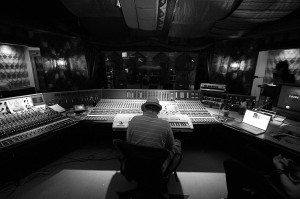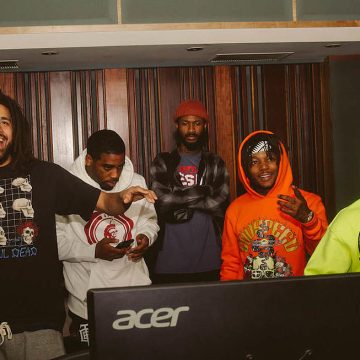Mixdown Mastery: 50 Effective Tips for Improving Your Mixdown Quality, Workflow, and Mixing Knowledge

Mixing down a track is just one of the many things required in music production, though more of a ‘technical’ craft – it’s still certainly creative, and it plays a huge part in music as a whole.
If you’re a bedroom producer, then it’s likely that you’re mixing down your own material. Sometimes it’s hard to know where to start, and often it can seem like a chore.
Because of this, I’ve decided to compile a list of tips that I and others use. Take these with a grain of salt, and please take the time to experiment and learn for yourself. The purpose of this is to give you some ideas or help you improve your work.
Feel free to share this article to anyone you think will benefit from it.
Preparation
The first 10 tips are about preparation, that is – preparing your track before the final mixdown, which leads to my first point.
1. Do a final mix at the end
We posted an article a while back on mixing as you go vs. mixing down at the end. A lot of people mixdown as they go, which is great, but it helps to do a final check and clean up at the end.
Separating the creative/musical and creative/technical side can be incredibly helpful, not only to workflow but production quality as a whole.
2. It all starts with sound design and sample selection
You know the old saying – you can’t polish a turd.
It applies to mixing. If you’re trying to mixdown a track that has a poorly designed bass, horrible kickdrum, and ugly hi-hat – then what’s the point?
Mixing is not something you do just at the end of your production, it’s something that you have to think about from the moment you open your DAW.
3. Be happy with everything else first
I know some people can work fine like this, but I find that jumping between mixing, arrangement, sound design, and musical creation is a nightmare.
Before doing the final mixdown, take a listen through your track a few times and make sure you’re content with the arrangement and everything else (you don’t have to be completely happy with how it sounds sonically, as you’ll be fixing that in the mixdown).
4. Label and color tracks
Some people will disagree with me here, but I think that labelling and coloring tracks speeds up workflow big time.
Our brain responds to color faster than it does to words. When mixing down it’s important you know what section you’re working on, you don’t want to EQ your bass while listening to your synth.
I typically color all my drums and percussion yellow, bass blue, and synths green.
Having an already set up template can help with this, and I recommend creating one.
5. Using audio over MIDI has its benefits
I’m not going to make any recommendations here, because I know many people who prefer not to bounce down to audio, and that’s fine.
Aside from this, there are actually a few benefits to working with audio:
- You can visually see where the audio starts and ends, making it easy to clear things up (reverb tails, delay tails, etc)
- It’s more CPU-friendly
- It’s easier to work with in general
As a preparation tip, bounce down certain elements to audio if you feel you’d work better that way.
6. Group similar tracks
This is something you may also do during the mixdown (wanting to even out two tracks for example). Grouping similar tracks can help you to achieve a more ‘unified’ sound through bus compression, EQ, reverb, and whatever else.
It’s also a lot easier to turn one fader down instead of 5. If your drum section is too loud, then you can simply turn the group fader down.
7. Mixdown earlier in the day, if possible
This will likely be controversial.
As far as I’m concerned, our ears don’t perform at 100% the whole time we’re awake. If you’re listening to music all day, or working in a place with loud noises – then mixing down afterwards can be dangerous due to your already fatigued ears.
Our ears are a lot more fresh and unbiased in the morning.
Whether this has an identifiable significant difference is another story, but it’s worth trying out.
8. Start with all the faders down
It’s a lot easier to get a good balance by turning the volume up from nothing. In preparation, turn all the faders down and then start with the element you want to be the loudest (in most EDM this would be the kick drum)
9. Highpass everything
You might want to do this after the preparation stage, I like to do it before.
Filter out all the unneeded low-end information from each track. Highpass up until the point where it affects the sound, and then pull it back a bit just to stay on the safe side. This is a good starting point.
10. Choose reference tracks
Mixing without reference tracks is like drinking alcohol for no apparent purpose. You feel great at the time, but in the morning when you wake up you ask yourself, “Why the hell did I do that?”
Don’t overestimate your abilities. Reference tracks are in my opinion, essential.
Read More: Getting the Most Out of Your Reference Tracks
Mixing in General
The next 25 tips are about mixing in general, this includes creative and technical aspects.
11. Start with your most important element
In any given song you’ll have one element that’s the most important. In an acoustic song it might be the vocal, in dubstep it might be the snare, and in trance it might be the kick.
Work out what this is and start with it, use it as a reference point and build all other elements around it (for this reason I typically start with the kick, any time I add an element that causes the kick to lose punch I know I need to adjust the new element).
12. Devote time to your mixdown
It takes time! Mixing down a track does not involve slapping a limiter on top and uploading it to Soundcloud saying ‘plz download’, it involves effort, hard work, and time.
If you know that you’re going out in 30 minutes, then it’s probably not the best time to start a mixdown. Find a time where you can commit a couple of hours solely to your mix.
13. Mix at low volume
Yes, cliché, I know. But it’s important that people understand this.
Mixing at a low level not only reduces the risk of ear fatigue (and permanent hearing damage), but it’s a great way to judge your mix more accurately because:
- You have less harsh room reflection
- You can get a more accurate balance, if you can’t hear something at a low level then it may be too quiet
- If it sounds good at a low volume, it’s generally going to sound good at a high volume
14. Mastering won’t fix anything
Don’t tell yourself that mastering will fix the problems you have in your mix. It simply won’t.
If the low-end is too loud, then fix it! If you’ve got a harsh high-end, fix it! Don’t just procrastinate and convince yourself that mastering will fix it.
15. Learn to use your tools
I see a lot of new producers posing questions like, “How good is compressor X?” Or, “Sick of Fruity Reverb, what do you recommend?”
Understand that I have no hate towards third party plugins, there’s no denying that they do sound better – but a new plugin will not make your mixdown sound significantly better if you don’t know how to use the tools first. If you’re unaware of how a compressor works, then why would you buy (or acquire) a different one?
Save money, and learn first.
16. Consider using volume automation instead of compression
Compression is a great tool, and it’s important that you understand how to use it. But, there are often times where volume automation is more applicable.
If you’ve got some loud peaks in your song, compression can fix them – but so can placing a little dip with an automation clip. It’s a lot more flexible and may just prove beneficial to you.
17. Subtle sidechaining can work wonders
I’m not talking ‘Call on Me‘ type sidechain compression, but rather so subtle that it’s almost inaudible.
Doing this creates a lot more room for the kick to punch through, and who says you need to sidechain with a kick? You could use another synth, or anything else. Be creative!
18. Spectrum analyzers are invaluable, but ultimately rely on your ear
You’d be silly to work without them, but it’s important that you make final calls with your ear. Use both!
Don’t have a spectrum analyzer? Check out SPAN.
19. Don’t blame your bad mix on the tools you have
Whether it’s VST’s, your DAW, or your monitoring environment – don’t make excuses.
My studio was lo-fi by necessity; I was fourteen with no reliable income. I was monitoring my music using $100 Logitech speakers, and I only used software. – Porter Robinson
Good tools help a lot, but they aren’t required. The most important thing is that you know your gear inside and out.
20. Don’t wear a beanie
Or anything else that covers your ears, for that matter.
Honestly, you’d be surprised at how often I see this. It’s completely stupid, listen to a song with a beanie on and take it off halfway through. Wearing something over your ears blocks out a lot of high-frequencies and is horrible for mixing and making music in general.
Are you reading this Avicii?
21. Be creative
Mixing isn’t all technical and logical. Splash out, try new stuff, add random effects.
Don’t get stuck in the ‘rules box’, where you don’t dare venture off from the fundamental guidelines. While these are important if you want to get a good sound – they’re only guidelines and not rules, if it sounds good – it sounds good.
22. Don’t overuse compression
At the end of the day, most of us are using digital instruments, meaning that we’re not really recording in anything that has an extreme variable volume. Because of this, most of our source material is already pretty even – it doesn’t have huge dynamic range.
Don’t use compression ‘just because’, use it if you need to or want to change the characteristic of a sound. If you’re working with vocals then you’ll almost definitely need to compress, but with soft synths it’s not always necessary.
23. Try a new technique
If you’re focused on learning how to mix better, then try something new. It might be parallel compression, or rhythmic delays.
On the other hand, if you’re doing a mixdown for someone – or releasing an important track, then play it safe and make sure you don’t screw anything up with your new technique.
24. Don’t copy other artists blindly
If Noisia boost their snares at 150Hz, then it doesn’t mean you should start doing it from then on in every song you make.
If you’re wanting to learn new techniques, you first have to workout why the producer did it. Was it to add more punch? Was it to clean up the mix?
Whatever it is, work out why they did it, and then adapt it to your own productions.
25. If you don’t know what it does, don’t use it
“Ohhh, what’s a flanger? Maybe I’ll stick this on my drums bus!”
Really though, if you’re not sure of what something does – why not research it? Or listen to the actual effect it has. Why are you using a transient shaper on your snare if you don’t know what it does? You get the idea.
Study and then use.
26. Recalibrate your ears
I’ll talk more about breaks in the workflow section, but after mixing for long hours at a time it’s important to take a long break (30-60 minutes or more) to completely recalibrate your ears so you can start fresh afterwards.
It helps to actually go somewhere without too much noise. While listening to music isn’t necessarily bad, it can be a distraction. Go outside, take a walk on the beach, at least get out of your chair!
27. Use automation to make your mix sound great
One thing I like to do is get my mix sounding good with minimal automation, and then leverage automation to make it sound fricken excellent.
The reason for this is that automation can be a big distraction, it’s quite a time consuming thing when done properly, but it’s that last 5% of a track that lets you show off your technical skill level and creativity.
So try to automate things after your basic mixdown. You may find that you run into some problems after automation, so you’ll have to fix them up at the end.
28. If it sounds good, leave it!
This goes for everything, mixing and sound design to creating melodies. Don’t overproduce, know when to stop.
If you EQ something, and it sounds good – just leave it! Don’t make it sound worse by adding a plethora of effects on top. Minimalism > trying to appear more creative.
Note: I realize a lot of people struggle with this. Try to build the habit of consciously asking yourself whether you need to add ‘Effect A’ or not.
29. There are no rules, only guidelines. Just don’t do the opposite
It’s the most cliché thing in music production, it probably gets said or typed as often as a baby gets born.
Guidelines are helpful, people shouldn’t despise them. Of course they can be avoided, but if someone tells you that you should have sub-bass in mono – don’t be a hipster and stick it in stereo.
Likewise, don’t try to stack 10 supersaws on top of 5 different pluck sounds. Unless you want your track to sound horrible.
30. Subtle white noise can make massive difference to a mix
There’s a reason why it’s used in 90% of EDM tracks. It’s a waveform that has no tone, and it’s great for filling out your mix.
Use it sparingly of course, there’s nothing worse than an abundance of white noise that drowns out everything else. You can use it rhythmically, sidechain it, whatever! Experiment.
31. Mix your drums and bass first
This might be a little contradictory to tip #11, and it is quite genre-dependent.
A lot of electronic dance music relies on the drums and bass as foundation elements. After all, that’s what makes people dance. Starting with these elements in your mix can provide a much easier template to work off compared to going backwards from something like the synths and FX.
It’s also arguably the hardest part to get right in the mix, so if you sort it out first then it’s less of a mission to do the rest.
32. The less detailed your low-end is, the better
The low-end is the hardest part to mix. Some people don’t realize that and crowd a lot of stuff down there.
K.I.S.S
You know what that means, right kids? Keep It Super Simple.
Above the 200Hz range you can be a little less careful, but anything below that is going to cause issues when it overlaps too much. Don’t get stuck in the muddiness.
Read: 5 Tips for Getting a Tight and Powerful Low-end
33. Always sleep on it
You’ve got your mixdown finished, it’s 2am in the morning. “Great!” You shout out loud, “Time to send it off to some labels.”
Hold up buddy.
You’ve just been mixing for the last 6 hours, there’s no way that what you’re hearing is completely accurate.
If you finish a mixdown, wait until the morning and listen to it with a pair of fresh ears. I know this is hard, as we all want to share our art with the world – but it’s better to be safe than sorry.
34. Clean up delay and reverb tails
If you want a one-way ticket to mud-land then don’t pay any attention to your reverb, delays, and spatial effects.
Reverb and delay tails are hard to overlook, and unfortunately they can add a lot of unwanted and unnecessary muddiness to the mix. I’d recommend bouncing down to audio as you can see where the tails end visually.
35. Use the bypass function
Sometimes we can be adding an effect, take compression for example – and think we’re making the sound better when in reality we’re not.
Most DAWs allow you to bypass an effect with a single mouse click. Do this while using a mixing plugin to hear the difference.
Some more expensive effects, such as plugins from the Waves Renaissance Bundle allow you to switch between two presets within the same VST/AU shell.
Workflow and Productivity
This section contains a few tips regarding studio productivity and working efficiently.
Again, take them with a grain of salt.
36. Be open to compromise
There are always going to be things in your mix that just don’t work out. You gotta let them come to an agreement, and sometimes that means eliminating an element regardless of how emotionally painful it is to do so.
Welcoming the fact that some things aren’t going to work, and knowing how to deal with it will increase your workflow tenfold. If you know that two elements just aren’t going to work together no matter what, then deleting one can save you hours of hassle and stress.
37. Do things in a logical order
Some high profile mix engineers know exactly what they’re doing and when, so it can seem like organized chaos.
But if you’re not someone who’s been doing it for 10+ years, then it makes more sense to work in a logical order. For example: Finding balance with faders and EQ, then adding compression, spatial effects, and automation.
Organizing your mixdown in sections like this is a great way to speed up workflow and stay motivated.
38. If you feel like you can’t be bothered, then don’t do it
Unless you’re making a living off mixdowns (and you probably wouldn’t be reading this if you were), then you shouldn’t think of mixing as something you ‘have to do’ right now.
If you’re not feeling it at the time, then wait until you do. If you go into a mixdown with a negative mindset, then you’re just going to half-ass it.
39. Work in bursts
Breaks are the best thing known to man. I like to work in 45 minute bursts when I’m mixing, and then take a 10-15 minute break.
Two reasons for this:
- You reduce the likelihood of ear fatigue
- You stay inspired and motivated
If you work constantly without taking breaks, you’ll probably get burnt out and also experience some degree of ear fatigue. Figure out what works best for you!
40. Learn your keyboard shortcuts
I know it’s horrendously boring to do so, but knowing your shortcuts will save you A LOT of time.
The most important ones are those that help you move around your playlist quickly, some DAWs allow you to set up custom key macros also. Read the manual to find out your DAW’s keyboard shortcuts.
Overall, keyboard shortcuts allow you to move around a lot quicker.
41. Don’t stress yourself out
Do one thing at a time and just keep on pushing through, mixing isn’t always fun – but it’s something that needs to be done with close attention. Don’t work on 5 things at once and you’ll find it’s much easier to keep on pushin’.
If you’re mentally stressed from something else, then it might not be the best time to start your mixdown.
42. Embrace Commitment
I’ve basically already said this, but do something and then leave it. Commit. A mixdown should not take two months!
43. Always save as new
Make the habit of saving as a new version every time. FL Studio has this feature (Ctrl + N), in other DAWs you might want to increment each time: Trackname_1, Trackname_2, etc.
Also, save frequently. I like to save after spending a bit of time on an effect or section of the song. There’s nothing worse that your PC or DAW crashing and losing everything you’ve done.
44. Make yourself comfortable
Like I said earlier in the article; you should devote time to this. Not heaps, but enough. Because of this, it helps to be comfortable.
If you don’t have a comfortable chair, then get one. If you have to constantly stare upwards at a screen that’s way above your head, then fix it. Making small adjustments like this will pay off in the end.
45. Don’t Rush It
Despite all this workflow and productivity advice, I must recommend not to rush the mixdown – which can be easy. I can’t give any tips for this, because it’s up to YOU to find the perfect balance.
Treat your music like it’s your own baby.
Learning and Becoming a Better Mixer
The last 5 tips include what I’ve personally done, and what I recommend to take your mixing to the next level. Whether you’re a beginner or intermediate, this should help you out.
46. Seek out negative feedback
Read that again.
And again.
Seeking out negative feedback is painful, but it’s tremendously helpful if you want to improve at your craft. If you’re showing some friends a song, ask them this question:
What DON’T you like about it?
This might sting a bit, but it’s far better than someone saying, “Yeah sounds mean bro.” Because that’s not going to help you improve.
47. Collaborate with others
If you’re a solo-producer then you’ll know that it’s easy to get stuck in your ways, you might have a lot of bad habits that haven’t come to light because you haven’t seen anyone else work.
Collaborating with other producers is a great way to pick their brains and find out some of their techniques. Whether it’s in person or over the internet, it’s something that I recommend everyone does!
48. Visit Pensado’s Place
Though this website is more aimed at the mix engineers compared to producers, it doesn’t mean you won’t get anything out of it. In fact, you’ll get loads out of it – there are interviews with highly regarded mix engineers, ‘in the studio’ type videos with Dave Pensado, and a lot more.
49. Read, read, and read more
There are a tonne of good books out there that can help you with your mixing, I’ve listed a few below:
- Mixing Secrets for the Small Studio
- The Mix Engineer’s Handbook
- Mixing Audio: Concepts, Practices, and Tools
50. Practice
Haha, you thought you’d avoided that word, didn’t you?
Nope, practice is the vital ingredient in all of this. Mix, mix, and mix again.
I mean, I can’t tell you how to practice… You’ve gotta go do it!
Wow, You Got This Far?
Thanks for reading through such a long article!
If you enjoyed this article, or it helped you in any way – I’d love it if you could leave a comment with your thoughts, or possibly share it around!
Source : http://edmprod.com/50-tips-mixdowns/




Our apologies, you must be logged in to post a comment.